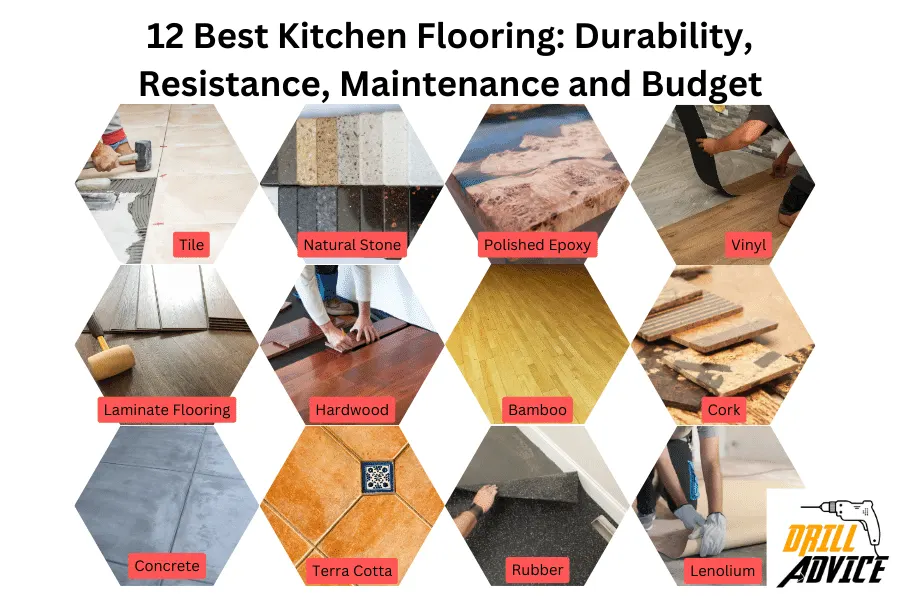
Kitchen flooring is a floor-covered material on the kitchen surface. The best kitchen flooring is based on higher durability, higher resistance, less maintenance and an affordable budget. By considering these factors below are the11 best kitchen flooring materials.
The 11 best kitchen flooring are tile, natural stone, polished epoxy, vinyl, laminate flooring, hardwood, bamboo flooring, cork flooring, concrete flooring, terra cotta tiles, rubber flooring, and Linoleum.
Durability is the period of which the material remains without any defect on the floor. When the materials are harder and tougher, it can last long years on the floor. But more brittle and shading material will be damaged easily due to outer force and effects in the kitchen..
Resistance is mainly 5 types. Those are water, stain, scratch, slip, and heat resistance.. These things should be considered before you choose a kitchen flooring material. Water resistance helps to prevent dampness to the floor. Stain resistance prevents the stain marks on the floor. Scratch resistance helps to prevent scratch marks on the floor due to equipment pulls on the floor. Slip resistance helps to prevent slippering on the floor. Heat resistance can prevent damage to the floor from the hot pot and equipment in the kitchen.
The kitchen flooring always gets wet and dirt. Hence, flooring should be cleaned regularly. Hence it can be damaged easily due to regular activities such as sweeping, washing, mopping and vacuuming. Therefore flooring should withstand regular cleaning and maintenance.
After considering all the factors, you should consider its affordability. Ensure that the kitchen material is affordable and does not exceed your budget. So let’s see the materials and its considerable while choosing a kitchen flooring.
What are the 12 Best Kitchen Flooring?
The best 12 kitchen flooring are;
- Tile
- Natural Stones
- Polished Epoxy
- Vinyl
- Laminate Flooring
- Hardwood
- Bamboo Flooring
- Cork Flooring
- Concrete Flooring
- Terra Cotta Tiles
- Rubber Flooring,
- Linoleum
Read More About – What to Know About Kitchen Backsplash? Size, Materials, and Recommendations
1. Tile
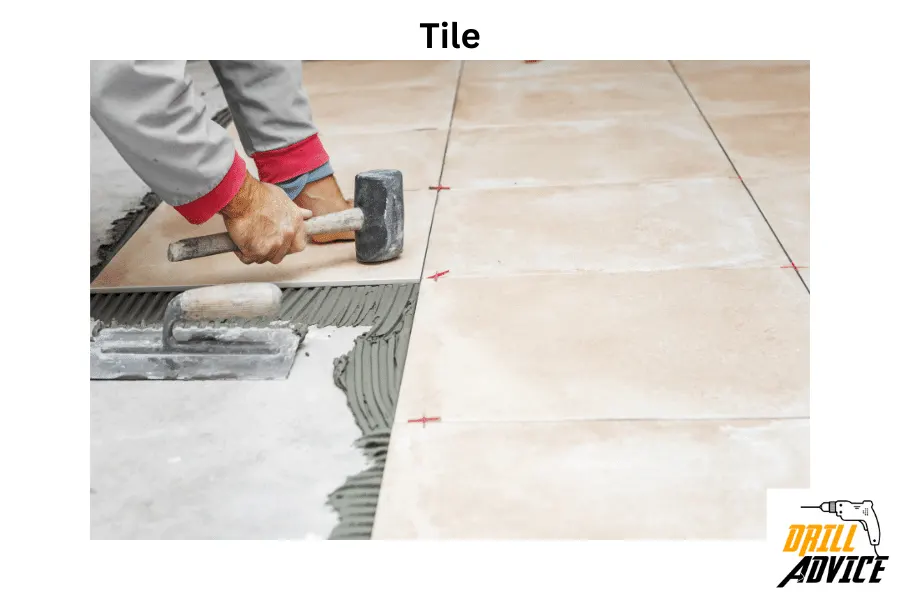
Tile flooring for kitchens consists of ceramic and porcelain. Ceramic tiles are made from clay materials that are quarried, prepared, and then formed into a mold. Porcelain is a type of ceramic tile that is made from a more refined clay and is fired at higher temperatures, making it more durable and less porous.
Tiles are hard, solid surfaces that don’t scratch easily. Porcelain is highly durable and withstands heavy foot traffic exceptionally well, making it ideal for busy kitchens. Ceramic is also durable but generally best suited for moderate-traffic areas.
| Factor | Description |
| Water Resistance | Tiles have higher water resistance. Therefore tile is suitable for kitchen flooring |
| Stain Resistance | Tiles are resistant to stain marks in the kitchen. |
| Slip Resistance | Textured surface tiles have higher slip resistance |
| Scratch Resistance | Porcelain tiles have higher scratch resistance, Hence it can protect from any scratches due to chair, or tables pulling on the kitchen floor. |
| Heat Resistance | Tiles can withstand heat. Hence high high-temperature pots, and plates can be placed of the flooring. |
- Cleaning of the Bathroom Tile Flooring
- Tile flooring is easy to clean. You should sweep, vacuum or mop according to the dirtness. Specially you should clean the grouts.
- Maintenance of the Bathroom Tile Flooring
- Tiles are low maintenance. Ceramic and porcelain rarely require anything beyond basic cleaning. Stone may need periodic sealing.
- Budget of the Bathroom Tile Flooring
- Tile can be more expensive upfront compared to options like laminate or vinyl kitchen flooring, but its durability makes it cost-effective in the long run.
Compared to other types of kitchen flooring like hardwood, laminate, or vinyl, tile offers superior water and stain resistance, making it a practical choice for kitchens. However, it can be harder underfoot and may require a larger initial investment.
2. Natural Stones
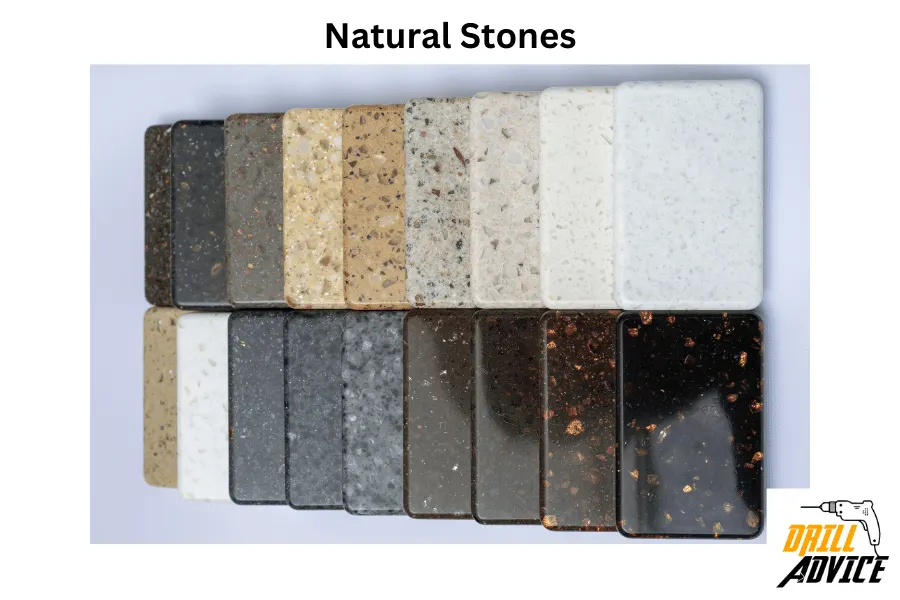
Natural stone are made from various geological materials that have formed over millennia. The most common types of natural stone used in kitchen flooring include marble, granite, slate, limestone, and travertine. Each stone has a distinctive look, providing a wide array of design possibilities.
Natural stone are robust and can last a lifetime if properly maintained. However, not all stones are created equal. Granite and slate are extremely durable and scratch-resistant, while marble and limestone are softer and more susceptible to wear and tear.
| Factor | Description |
| Water Resistance | The Water resistance of natural stone is varied by the stone type. In order to improve the water-resistance of the natural stone, its surface should be sealed. |
| Stain Resistance | Sealed surface will resist the stain marks in the kitchen floor.. |
| Slip Resistance | A sealed surface will resist the stain marks in the kitchen floor.. |
| Scratch Resistance | Highly durable but can vary by stone type |
| Heat Resistance | Nautral stones have excellent heat resistance. |
- Cleaning of the Bathroom’s Natural Stone Flooring
- Generally, natural stones are easy to clean but it require special cleaning agents to avoid damage. Always avoid acidic cleaners on natural stone, as they can etch the surface.
- Maintenance of the Bathroom’s Natural Stone Flooring
- Natural stones require regular sealing to protect against stains and water damage. The frequency of sealing will depend on the type of stone and the wear it experiences.
- Budget of the Bathroom’s Natural Stone Flooring
- Natural stone is an expensive kitchen flooring, both for the material itself and for the installation, which often requires professional expertise.
Compared to other flooring options like ceramic tile or hardwood, natural stone offers unparalleled beauty and uniqueness but requires a greater commitment to maintenance. The upfront cost for the kitchen flooring is also generally higher, but many homeowners find the aesthetic and functional benefits worth the investment.
3. Polished Epoxy
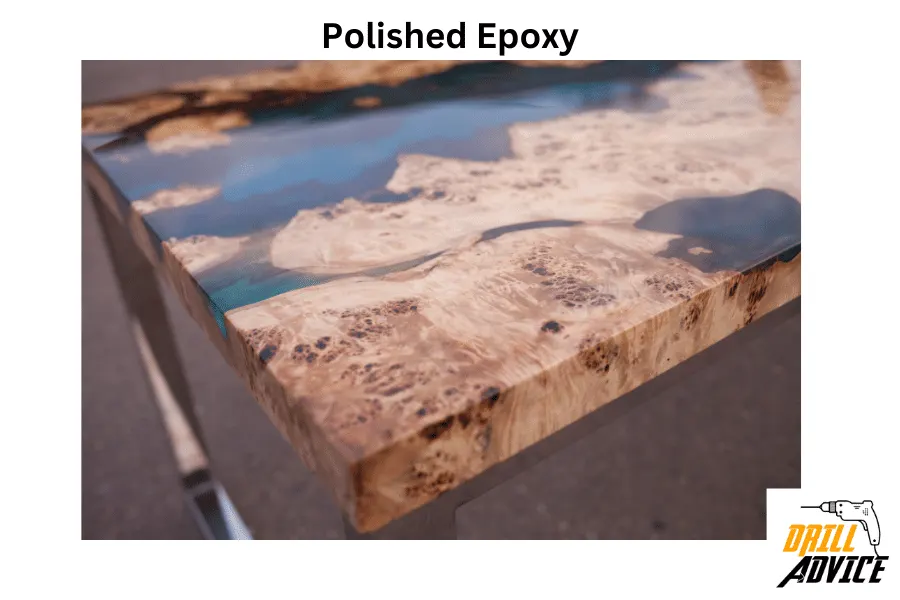
Epoxy flooring consists of a two-part system: a layer of epoxy resin is applied over a hardener. When these two components are mixed, they form a chemical bond with each other and the substrate, creating a rigid plastic material that’s both strong and resistant. Polishing gives the epoxy a glossy, high-shine finish.
Epoxy flooring is extremely durable, and designed to withstand heavy traffic, chemical spills, and other forms of wear and tear. The polished finish doesn’t just add aesthetic appeal; it also improve the floor’s natural resistance.
| Factor | Description |
| Water Resistance | Polished epoxy has a higher water resistance hence it can be used as kitchen flooring. |
| Stain Resistance | Polished epoxy resist most of the stain marks in the kitchen floor except chemical stan marks. |
| Slip Resistance | Polished epoxy can be slippery when the kitchen flooring is wet. In order to prevent it there are anti-slip additives. |
| Scratch Resistance | Highly resistant to scratches and dents occur on the kitchen floor. |
| Heat Resistance | Polished epoxy is heat resistant. But it is not as good as natural stone. |
- Cleaning of the Bathroom Polished Epoxy Flooring
- Epoxy flooring can be cleaned using a neutral PH cleaner. The kitchen floor can be swipe, mopped and washed without any drawback.
- Maintenance of the Bathroom Polished Epoxy Flooring
- The polished epoxy kitchen floor needs very low maintenance. Polished epoxy flooring does not require any sealing or waxing. However, it may require professional re-coating after several years to maintain its appearance.
- Budget of the Bathroom Polished Epoxy Flooring
- While the material itself is not overly expensive, the cost of professional installation can add up. Overall, it is a moderate to high investment but offers long-term durability.
Compared to other types of kitchen flooring like natural stone, tiles, or hardwood, epoxy offers a highly durable and low-maintenance option. However, its sleek, industrial look may not be for everyone, and it can be slippery when wet unless treated with anti-slip additives.
4. Vinyl
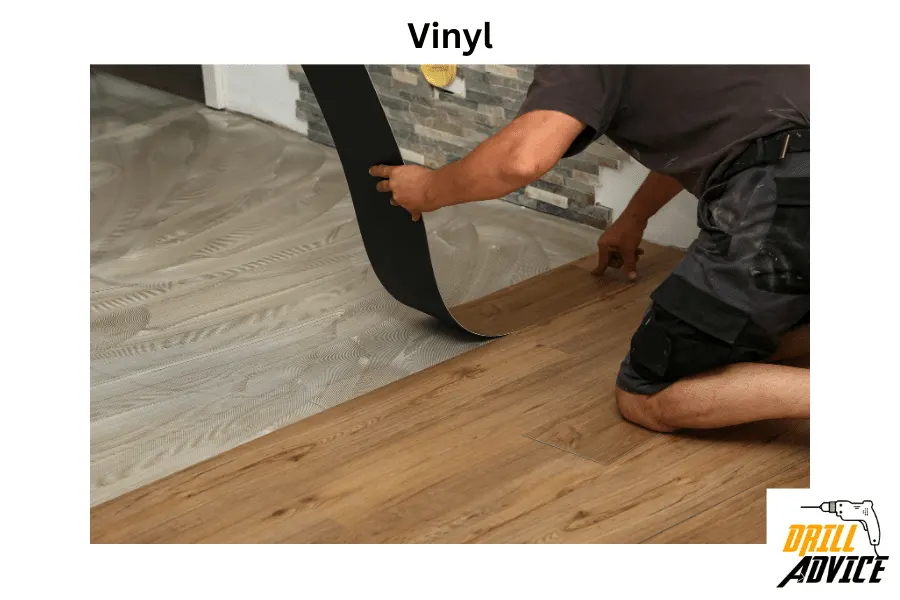
Vinyl flooring is a synthetic material that comes in a variety of formats, including sheets, tiles, and planks. The core layer is made of PVC (polyvinyl chloride) plastic, combined with various other materials to improve durability and aesthetics. The top layer is usually a wear layer that protects against scratches and stains, and this is often covered with a printed design layer that can mimic everything from hardwood to natural stone.
Vinyl is known for its durability and resilience. Its toughness allows it to withstand heavy foot traffic in the kitchen triangle. Higher-quality vinyl options often come with enhanced wear layers that further improve durability and resistance to moisture and stains.
| Factor | Description |
| Water Resistance | Vinyl is a stain-resistant flooring. Hence it can be used as a kitchen flooring. |
| Stain Resistance | Vinyl is a stain-resistant flooring. Hence it can be used as kitchen flooring. |
| Slip Resistance | Vinyl flooring has textured options. That can prevent the slippering on the kitchen floor. |
| Scratch Resistance | Vinyl has a moderated scratch resistance. The scratch resistance depends on the layer thickness. |
| Heat Resistance | Vinyl flooring has moderate heat resistance. It is not higher than tile of stones. |
- Cleaning of the Bathroom Vinyl Flooring
- Vinyl flooring can be cleaned easily. Hence kitchen floor can be swept and mopped with a gentle cleaner.
- Maintenance of the Bathroom Vinyl Flooring
- Vinyl kitchen floor requires low maintenance. Unlike wood or stone, vinyl does not need to be sealed or waxed.
- Budget of the Bathroom Vinyl Flooring
- One of the most cost-effective options. Even high-quality vinyl is generally more affordable than most other types of flooring.
Comparison with Other Types of Kitchen Flooring
- Compared to hardwood, vinyl flooring is more water and stain-resistant but might not offer the same level of aesthetic appeal.
- When stacked against tile, vinyl is softer underfoot and less expensive but may not be as durable in the long term.
- Against natural stone or polished epoxy, vinyl is less expensive and easier to install but doesn’t offer the same high-end look or extreme durability.
5. Laminate Flooring

Laminate flooring is a synthetic product that mimics the look of hardwood, tile, or stone. It consists of several layers, including a bottom stabilizing layer, a core layer of high-density fiberboard (HDF), a decorative layer with the chosen design, and a protective top layer usually made of aluminum oxide.
Laminate flooring is notably durable and resistant to many types of wear and tear, scratches and dents. Higher-quality laminate flooring has better durability hence, laminate is a good flooring for the kitchen.
| Factor | Description |
| Water Resistance | Laminate flooring has moderate water resistance. |
| Stain Resistance | Laminate flooring are highly stain resistant. Hence it is a suitable kitchen flooring. |
| Slip Resistance | Laminate flooring textured finishes are less slippery. |
| Scratch Resistance | Laminate flooring top layer is designed to resist scratching |
| Heat Resistance | Laminate flooring has a moderate heat resistance. But it is not higher than than the tile or natural stone. |
- Cleaning of the Bathroom Laminate Flooring
- Laminate flooring can be clean easily. So when it is used for the kitchen flooring, it can be easy to clean with regular sweeping and mopping using a mild cleaner.
- Maintenance of the Bathroom Laminate Flooring
- Laminate flooring requires low maintenance; no need for sealing or waxing. However, if a section gets damaged, you might need to replace that particular piece.
- Budget of the Bathroom Laminate Flooring
- Generally more cost-effective than hardwood, tile, or natural stone.
- When compared to hardwood flooring, laminate flooring is less expensive and offers better stain resistance to kitchen flooring.
6. Hardwood
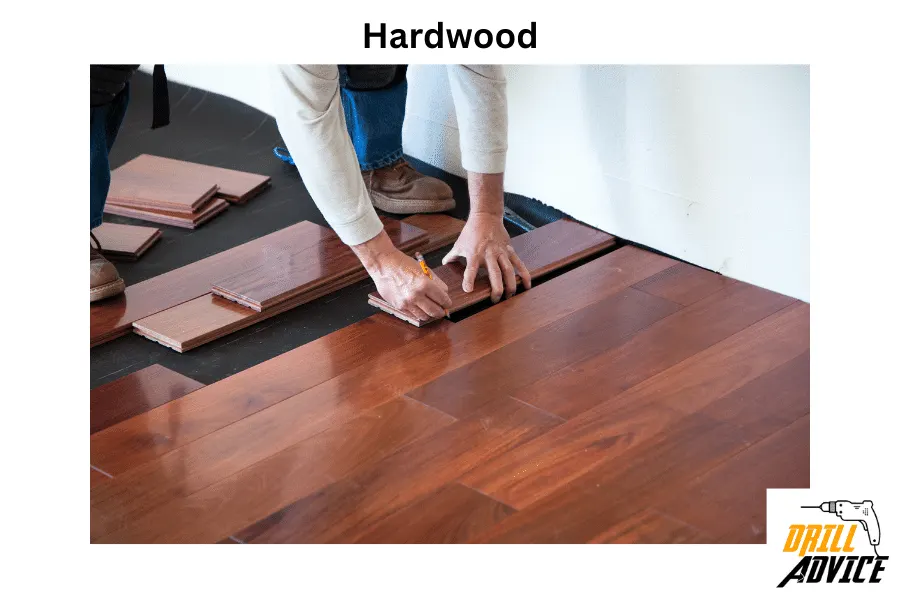
Hardwood flooring is made from solid wood. Hardwood is harvested from various tree species like oak, maple, cherry, and hickory, among others. Each species has its unique characteristics, including grain pattern, hardness, and color variations. Hardwood planks can come in various widths and finishes, giving you a wide range of options to fit your kitchen’s style.
Hardwood floors are known for their long-lasting durability, but they’re not invincible. The durability largely depends on the type of wood you choose; for instance, oak is generally more resilient than pine. With proper care and maintenance, hardwood floors can last for decades, but they are susceptible to scratches, dents, and water damage.
| Factor | Description |
| Water Resistance | Hardwood kitchen flooring can be damaged with remain water on the surface. |
| Stain Resistance | Hardwood kitchen flooring has moderate stain resistance. But stain marks can be removed by sanding and refinishing. |
| Slip Resistance | Hardwood kitchen flooring has a natural slip-resistant. |
| Scratch Resistance | Hardwood kitchen flooring has a higher scratch resistance than the softwood kitchen floorings. |
| Heat Resistance | Wood is a natural insulator but can be affected by extreme changes in temperature |
- Cleaning of the Bathroom Hardwood Flooring
- Hardwood kitchen flooring requires regular sweeping or vacuuming and occasional mopping with a wood-safe cleaner.
- Maintenance of the Bathroom Hardwood Flooring
- Hardwood kitchen flooring requires periodic refinishing to remove scratches and restore luster, depending on the level of wear and tear.
- Budget of the Bathroom Hardwood Flooring
- Hardwood kitchen flooring is more expensive upfront than laminate or vinyl but can be a long-term investment due to its durability.
- Compared to laminate kitchen flooring, hardwood offers a more authentic look and feel but requires more maintenance and is more expensive.
- Against tile, hardwood is warmer underfoot and offers a cozier aesthetic but isn’t as water-resistant.
- Versus vinyl, hardwood is more durable and can be refinished but comes at a higher cost and needs more regular maintenance..
7. Bamboo Flooring
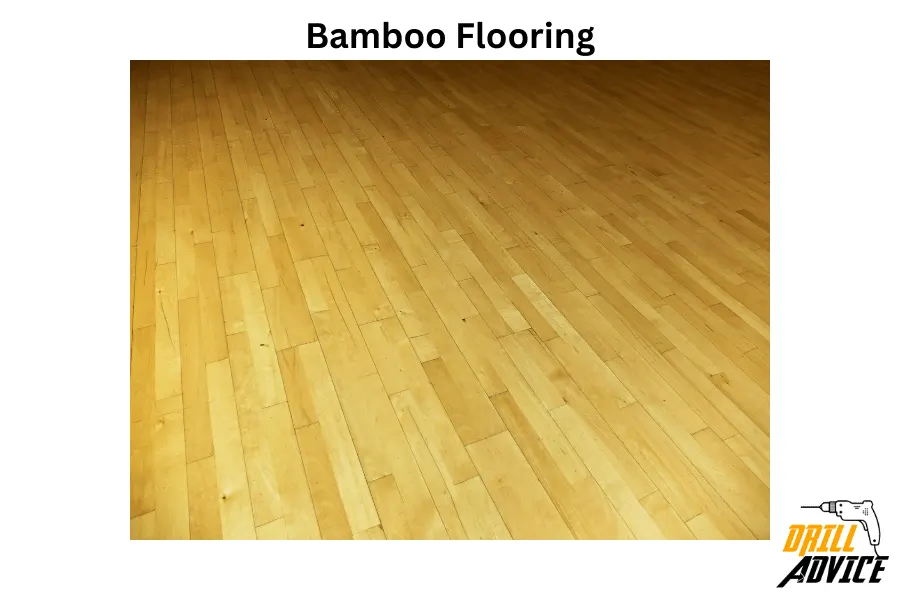
Bamboo flooring is crafted from the bamboo plant. Bamboo plant is type of fast-growing grass that can mature in as little as three to five years. This quick regeneration makes it a sustainable alternative to traditional hardwoods. Bamboo flooring is available in various styles, including horizontal, vertical, and strand-woven. Due to these factors, bamboo can be used as kitchen flooring.
Bamboo is a surprisingly durable flooring material. The strand-woven type is harder than some hardwoods. Bamboo has a scratch resistance and water resistance. Hence it can be used as a kitchen flooring.
| Factor | Description |
| Water Resistance | Bamboo has moderate water resistance but it is better than hardwood. Bamboo should not be used in higher wet areas. |
| Stain Resistance | Bamboo flooring has better stain resistance |
| Slip Resistance | Bamboo flooring has better slip resistance |
| Scratch Resistance | Bamboo flooring has moderate scratch resistance |
| Heat Resistance | Bamboo flooring has moderate heat resistance but it can be affected by extreme temperature changes |
- Cleaning of the Bathroom Bamboo Flooring
- Bamboo kitchen flooring can be sweeping or vacuumed and occasionally mopped with a bamboo- or wood-safe cleaner.
- Maintenance of the Bathroom Bamboo Flooring
- Bamboo flooring requires low to moderate maintenance.
- Budget of the Bathroom Bamboo Flooring
- Generally, bamboo flooring is priced similarly to hardwood but can vary depending on the quality and type.
- Compared to hardwood, bamboo offers a similar aesthetic and feel but has the added benefit of being more eco-friendly.
- Against tile, bamboo is softer underfoot and warmer but less water-resistant.
- Versus laminate or vinyl, bamboo offers a more authentic, natural look but typically at a higher price point and with potentially more maintenance.
8. Cork Flooring
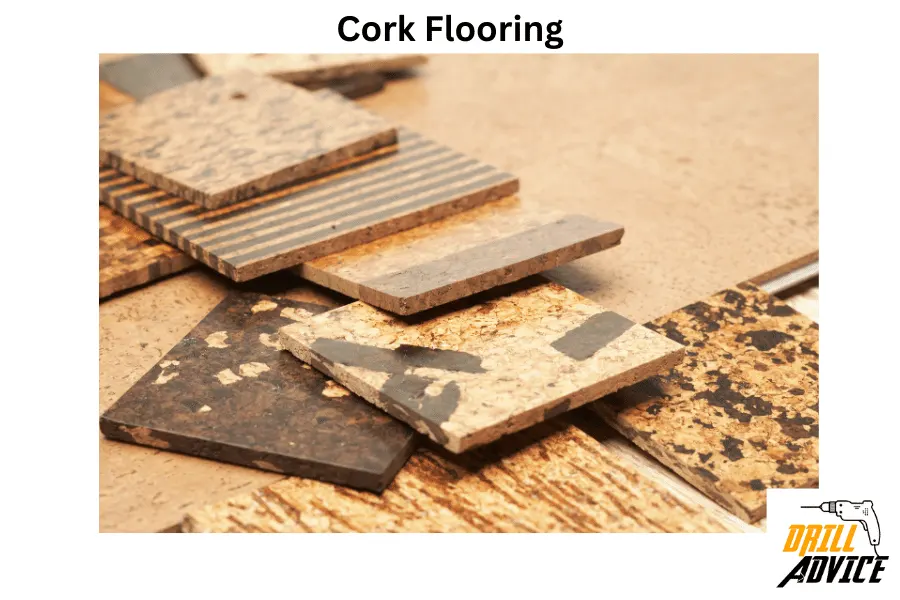
Cork flooring is made from the bark of the cork oak tree. Cork is, a renewable resource that can be harvested without damaging the tree itself. This bark regenerates, making cork a sustainable choice. The flooring comes in both tiles and planks and can be installed in various methods, including floating or glue-down applications.
Cork is naturally resilient, providing a cushiony surface that’s kind to your joints. It’s also a good insulator, keeping your kitchen warm in the winter and cool in the summer. While cork is generally durable, it’s softer than hardwood and can be susceptible to dents from heavy furniture or appliances and may also suffer from excessive moisture.
| Factor | Description |
| Water Resistance | Cork has moderate water resistance. When the cork is sealed its water resistance can be improved. |
| Stain Resistance | Properly sealed cork flooring has a better stain resistant |
| Slip Resistance | Cork has a natural texture. It provides a better grip to prevent slippering. |
| Scratch Resistance | Moderate; softer than hardwood and can be prone to dents |
- Cleaning of the Bathroom Cork Flooring
- Cork kitchen flooring can be regularly cleaned and mopped using a mild, pH-balanced cleaner.
- Maintenance of the Bathroom Cork Flooring
- Cork kitchen flooring needs maintenance to improve its water and stain resistance after a few years.
- Budget of the Bathroom Cork Flooring
- Generally more affordable than hardwood but more expensive than laminate or vinyl.
- Compared to hardwood, cork is more eco-friendly and offers cushioning but is less durable.
- Against tile, cork is warmer and more comfortable underfoot but less resistant to water and dents.
- Versus bamboo or laminate, cork provides a uniquely cushioned surface and excellent insulating properties but may require more frequent maintenance.
9. Concrete Flooring

Concrete flooring is essentially a poured slab of concrete. After concrete is pouring it is polished, stained, or textured to create a specific look. Concrete flooring is commonly associated with commercial spaces and outdoor areas.
Concrete is exceptionally durable and can handle a lot of wear and tear. Concrete is suitable for high-traffic areas like kitchens. It’s resistant to many of the challenges that can affect other types of flooring, such as dents and scratches.
| Factor | Description |
| Water Resistance | A properly sealed concrete flooring has excellent water resistance. |
| Stain Resistance | A properly sealed concrete flooring has a better stain resistance. |
| Slip Resistance | A properly textured concrete flooring has a better slip resistance |
| Scratch Resistance | The concrete hard surface has a excellent scratch resistance. |
| Heat Resistance | Excellent; can even be used with radiant heating systems |
- Cleaning of the Bathroom Concrete Flooring
- Concrete flooring is easy to clean with regular sweeping and mopping. Hence it can be used as kitchen flooring.
- Maintenance of the Bathroom Concrete Flooring
- Concrete flooring require re-sealing every few years. Maintenance depends on the level of wear and tear of the floor.
- Budget of the Bathroom Concrete Flooring
- Varies widely based on customization options like staining and texturing, but generally mid-range in cost.
- Compared to hardwood or bamboo, concrete is far more durable but lacks the warm, natural aesthetic.
- Against tile, concrete offers a more unified, seamless look but is harder underfoot.
- Versus cork or laminate, concrete is a more permanent, long-lasting option but lacks comfort and softness.
10. Terra Cotta Tiles
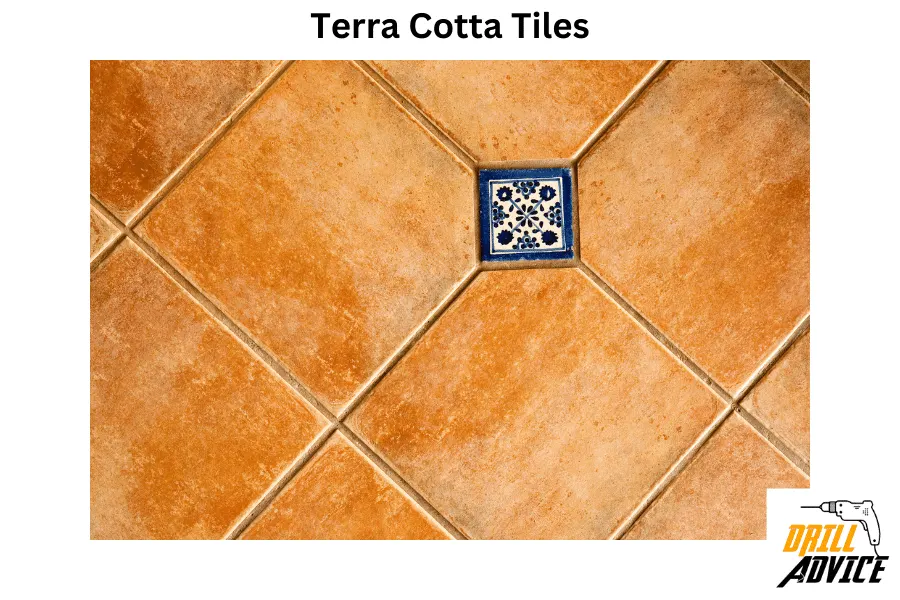
Terra cotta tiles are ceramic tiles made from a specific type of clay that has been fired at a lower temperature than most other ceramics. This results in a porous tile with a reddish-brown color. They come in various shapes and sizes, typically square or rectangular, and can be treated with various glazes or finishes to achieve different looks.
While terra cotta tiles offer an authentic, old-world feel, it’s important to note that they are softer and more porous than other types of ceramic or porcelain tiles. This makes them susceptible to scratches and chips. However, their durability can be improved with proper sealing and maintenance.
| Factor | Description |
| Water Resistance | Terra cotta tiles have moderate water resistance. In order to improve the water resistance it should be sealed. |
| Stain Resistance | Terra cotta tiles have moderate stain resistance but it can improve with the sealing. |
| Slip Resistance | Terra cotta tiles have better slip resistance due their texture. |
| Scratch Resistance | Terra cotta tiles have a low scratch resistance. It can be scratched in the kitchen due to pulling the tables, and chairs on the floor. |
| Heat Resistance | Terra cotta tiles has excellent heat resistance. |
- Cleaning of the Bathroom Terra Cotta Tiles
- Terra cotta kitchen flooring requires regular sweeping and occasional wet mopping with a mild detergent.
- Maintenance of the Bathroom Terra Cotta Tiles
- Terra cotta kitchen flooring requires regular sealing to enhance durability and resistance to water and stains.
- Budget of the Bathroom Terra Cotta Tiles
- Generally affordable, though high-quality or hand-painted tiles can be expensive.
11. Rubber Flooring
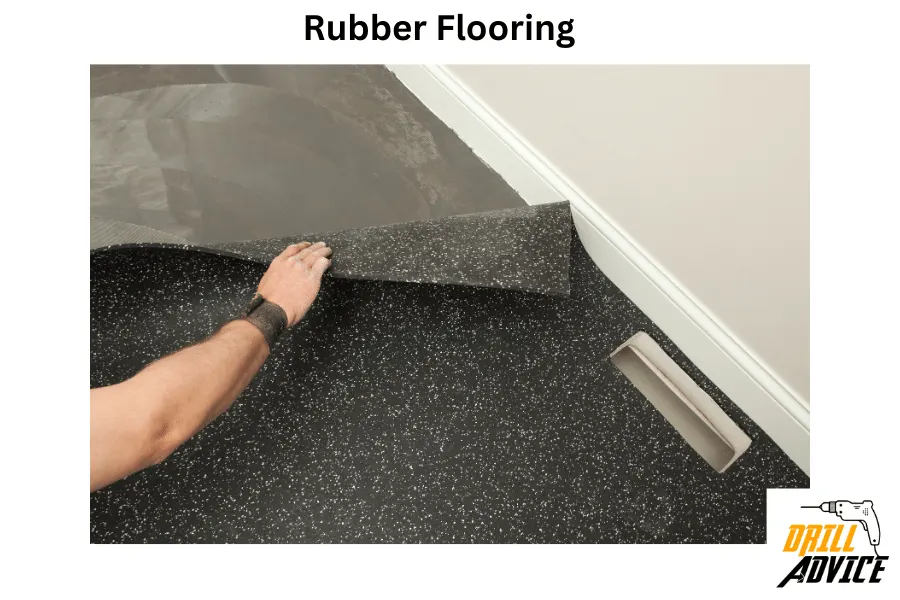
Rubber flooring is made from either natural tree rubber or synthetic materials that mimic the feel and durability of natural rubber. It comes in various forms, including tiles, rolls, and mats. You’ll also find it in a wide range of colors and textures, from smooth to studded, making it highly customizable.
Rubber flooring is incredibly durable and resilient, able to withstand high levels of foot traffic, spills, and drops. Its give provides comfort underfoot, reducing fatigue for those who spend a lot of time in the kitchen.
| Factor | Description |
| Water Resistance | Rubber kitchen flooring has excellent water resistance. |
| Stain Resistance | Rubber kitchen flooring has lower stain resistance. |
| Slip Resistance | Rubber kitchen flooring has excellent slip resistance. |
| Scratch Resistance | Rubber kitchen flooring has poor scratch resistance. |
| Heat Resistance | Rubber kitchen flooring has higher heat resistance. But it does not withstand higher temperatures. |
- Cleaning of the Bathroom Rubber Flooring
- Rubber kitchen flooring can be cleaned easily by sweeping and mopping with mild detergent.
- Maintenance of the Bathroom Rubber Flooring
- Rubber kitchen flooring require lower maintenance.
- Budget of the Bathroom Rubber Flooring
- Rubber kitchen flooring costs can vary but it is generally more affordable than premium materials like hardwood or high-end tile.
12. Linoleum
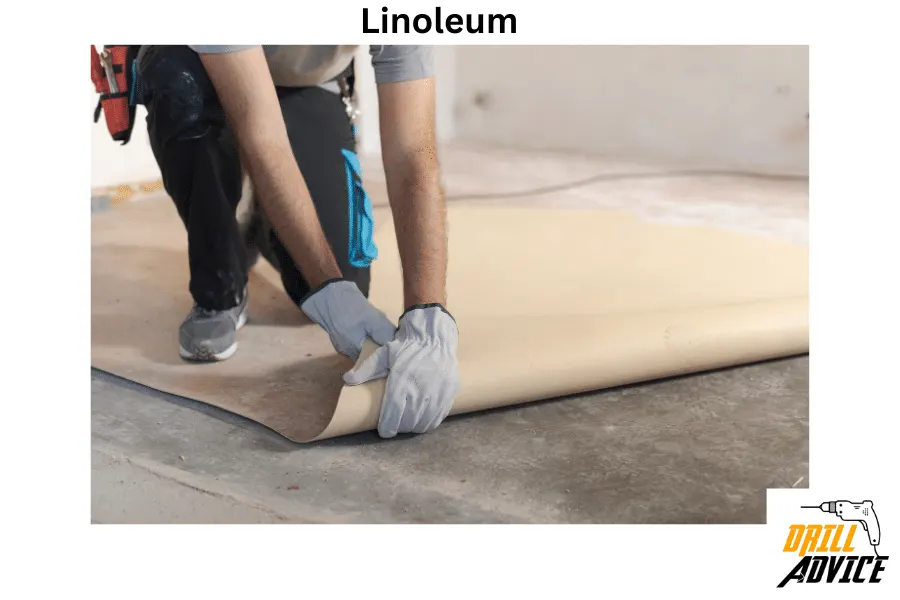
Linoleum is made from natural materials. Linoleum consists of linseed oil, pine resin, cork dust, and wood flour, all laid upon a canvas or jute backing. Unlike vinyl, which is synthetic, linoleum is biodegradable and environmentally friendly. It comes in sheets, tiles, or planks and offers a wide array of colours and patterns.
Linoleum is durable and last long material of 25 to 40 years if it well-maintained. It’s a solid option for high-traffic areas like kitchens. However, it’s important to note that linoleum is susceptible to moisture damage if not properly sealed, and can also be susceptible to fading if exposed to direct sunlight for extended periods.
| Factor | Description |
| Water Resistance | Linoleum flooring has moderate water resistance. But it can improve with sealing. |
| Stain Resistance | Linoleum flooring has moderate stain resistance. But it can improve with sealing. |
| Slip Resistance | Linoleum flooring has a natural slip resistance. |
| Scratch Resistance | Linoleum flooring has moderate scratch resistance. |
| Heat Resistance | Linoleum flooring has a good heat resistance. |
- Cleaning of the Bathroom Linoleum Flooring
- Linoleum kitchen flooring is easy to clean. It can be cleaned by sweeping and mopping with a mild cleaner.
- Maintenance of the Bathroom Linoleum Flooring
- Linoleum kitchen flooring requires periodic sealing to maintain water and stain resistance.
- Budget of the Bathroom Linoleum Flooring
- Linoleum kitchen flooring is cost-effective. It is less expensive than hardwood or natural stone but more than vinyl.
- Compared to hardwood, linoleum is less expensive and more water-resistant but doesn’t offer the same timeless look.
- Against tile, linoleum is softer and warmer underfoot but may not be as durable.
- Versus rubber or cork, linoleum offers a wider range of design options but may require more maintenance.
